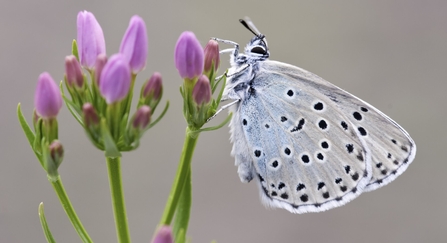The blue butterflies are some of the most stunning insects to be found in the UK. To many, they are the optimal sight on a hot summer’s day spent on a species-rich grassland. Not all are constrained to grasslands though, and they make use of a wide variety of habitats. They belong to a subfamily called the Polyommatinae, with nine resident species in the UK. The name ‘blue’ can be confusing, as some species show strong sexual dimorphism (where males and females look very different), with females being predominantly brown. In some species, neither sex is blue at all.
Most blue butterflies have a close relationship with ants, a phenomenon called myrmecophily. In this subfamily, the larvae produce a sweet secretion from a ‘honey’ gland, which is a food source to ants. The ants are attracted to this and tend to the larvae, who in return are offered a level of protection from potential predators and parasites. As we will discover, this relationship is not essential for all blue butterflies, whereas others are dependent on ants to complete their life cycle – sometimes to the detriment of the ants.
Some species are easy to identify, but others can be difficult to distinguish and rely on closer inspection, particularly of the markings on the undersides. It can help to know which larval hostplants are used for egg-laying, and therefore each species’ preferred habitat, as well as the months in which they’re flying. Some species are single brooded (only one generation each year), while others can have second and even third broods. We will have a look at each species, with tips on where and when to look for them, and key features to confirm identification.









